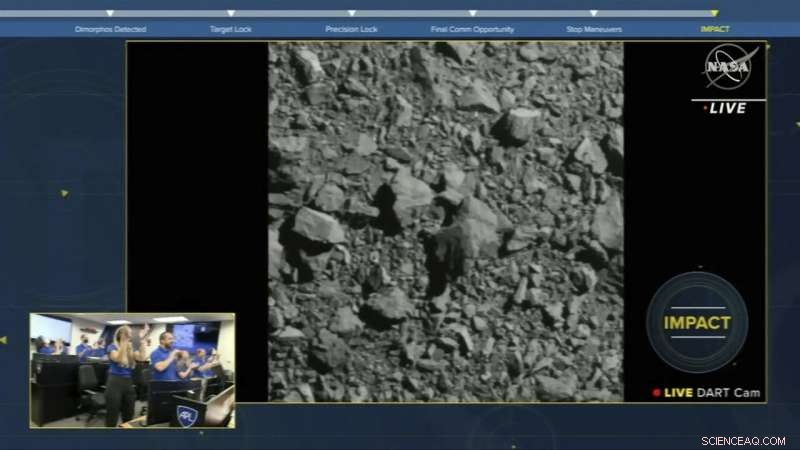
In questa immagine tratta da un live streaming della NASA, la navicella spaziale Double Asteroid Redirection Test si schianta contro un asteroide lunedì 26 settembre 2022. Credit:ASI/NASA via AP
Un veicolo spaziale della NASA ha speronato un asteroide a velocità vertiginosa lunedì in una prova generale senza precedenti per il giorno in cui un rock killer minaccia la Terra.
Lo slam galattico si è verificato su un innocuo asteroide a 7 milioni di miglia (11,3 milioni di chilometri) di distanza, con il veicolo spaziale chiamato DART che si è abbattuto nella roccia spaziale a 14.000 mph (22.500 km/h). Gli scienziati si aspettavano che l'impatto avrebbe scavato un cratere, scagliato flussi di rocce e sporcizia nello spazio e, soprattutto, avrebbe alterato l'orbita dell'asteroide.
"Abbiamo un impatto!" annunciò Elena Adams di Mission Control, saltando su e giù e alzando le braccia verso il cielo.
Telescopi in giro per il mondo e nello spazio puntati nello stesso punto del cielo per catturare lo spettacolo. Sebbene l'impatto sia stato immediatamente evidente (il segnale radio di DART è cessato bruscamente), ci vorranno fino a un paio di mesi per determinare di quanto è cambiato il percorso dell'asteroide.
La missione da 325 milioni di dollari è stato il primo tentativo di spostare la posizione di un asteroide o di qualsiasi altro oggetto naturale nello spazio.
"Per quanto ne sappiamo, il nostro primo test di difesa planetaria è stato un successo", ha detto in seguito Adams in una conferenza stampa, la stanza si è riempita di applausi. "Penso che i terrestri dovrebbero dormire meglio. Sicuramente lo farò."
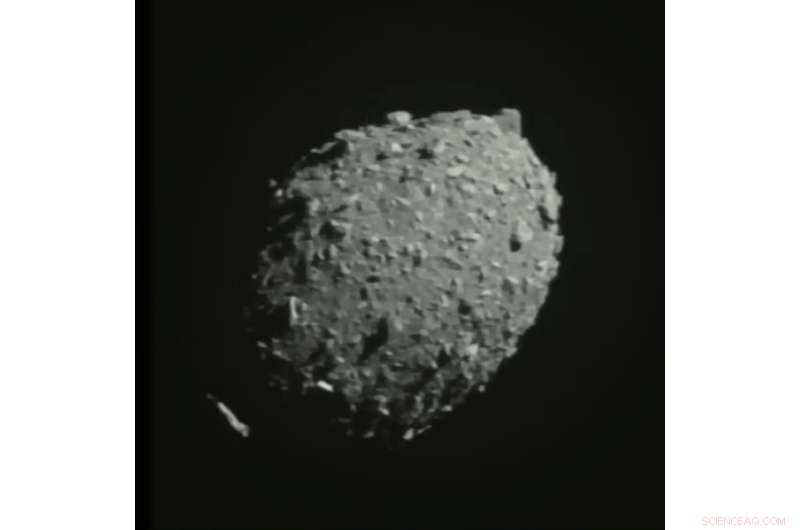
In questa immagine realizzata da un livestream della NASA e presa dalla navicella spaziale Double Asteroid Redirection Test, l'asteroide Dimorphos è visto mentre la navicella vola verso di esso, lunedì 26 settembre 2022. Credit:ASI/NASA via AP
L'amministratore della NASA Bill Nelson ha ricordato alle persone all'inizio della giornata tramite Twitter che "No, questa non è la trama di un film". He added in a prerecorded video:"We've all seen it on movies like "Armageddon," but the real-life stakes are high."
Monday's target:a 525-foot (160-meter) asteroid named Dimorphos. It's a moonlet of Didymos, Greek for twin, a fast-spinning asteroid five times bigger that flung off the material that formed the junior partner.
The pair have been orbiting the sun for eons without threatening Earth, making them ideal save-the-world test candidates.
Launched last November, the vending machine-size DART—short for Double Asteroid Redirection Test—navigated to its target using new technology developed by Johns Hopkins University's Applied Physics Laboratory, the spacecraft builder and mission manager.
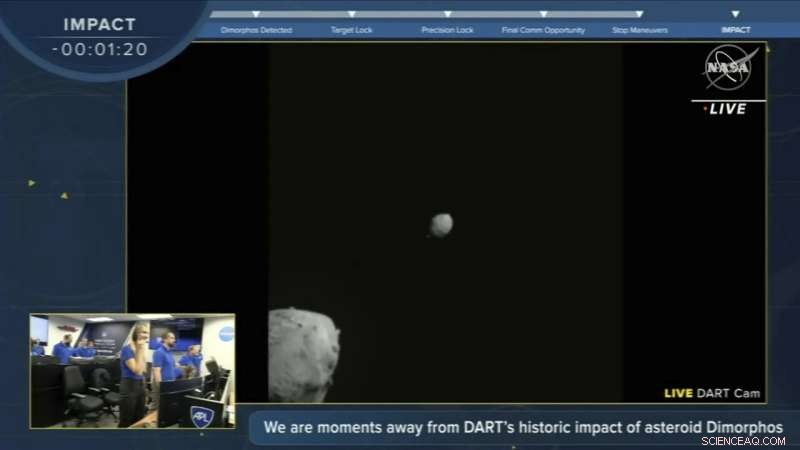
In this image made from a NASA livestream, the Double Asteroid Redirection Test spacecraft approaches asteroid Dimorphos, center, as larger asteroid Didymos fades away from view on Monday, Sept. 26, 2022. Credit:ASI/NASA via AP
DART's on-board camera, a key part of this smart navigation system, caught sight of Dimorphos barely an hour before impact. "Woo hoo!" exclaimed Adams, a mission systems engineer at Johns Hopkins.
With an image beaming back to Earth every second, Adams and other ground controllers in Laurel, Maryland, watched with growing excitement as Dimorphos loomed larger and larger in the field of view alongside its bigger companion. Within minutes, Dimorphos was alone in the pictures; it looked like a giant gray lemon, but with boulders and rubble on the surface. The last image froze on the screen as the radio transmission ended.
Flight controllers cheered, hugged one another and exchanged high fives. Their mission complete, the DART team went straight into celebration mode. There was little sorrow over the spacecraft's demise.
"Normally, losing signal from a spacecraft is a very bad thing. But in this case, it was the ideal outcome," said NASA program scientist Tom Statler.
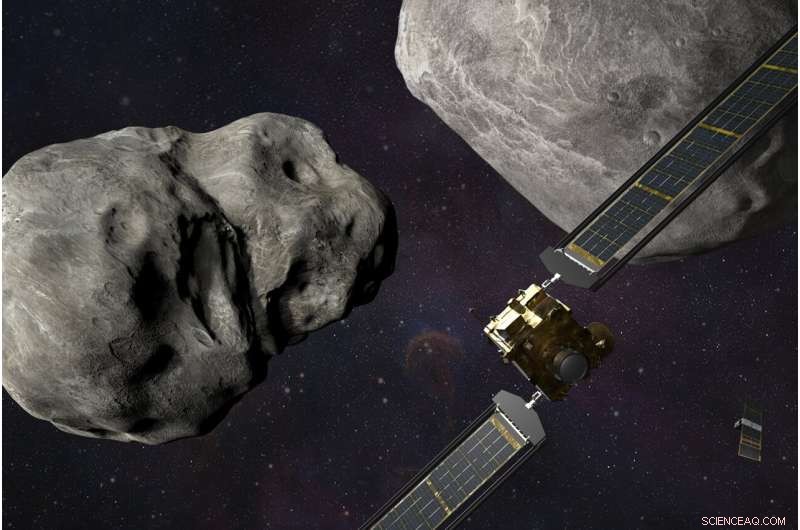
This illustration made available by Johns Hopkins APL and NASA depicts NASA's DART probe, foreground right, and Italian Space Agency's (ASI) LICIACube, bottom right, at the Didymos system before impact with the asteroid Dimorphos, left. DART is expected to zero in on the asteroid Monday, Sept. 26, 2022, intent on slamming it head-on at 14,000 mph. The impact should be just enough to nudge the asteroid into a slightly tighter orbit around its companion space rock. Credit:Steve Gribben/Johns Hopkins APL/NASA via AP
Johns Hopkins scientist Carolyn Ernst said the spacecraft was definitely "kaput," with remnants possibly in the fresh crater or cascading into space with the asteroid's ejected material.
Scientists insisted DART would not shatter Dimorphos. The spacecraft packed a scant 1,260 pounds (570 kilograms), compared with the asteroid's 11 billion pounds (5 billion kilograms). But that should be plenty to shrink its 11-hour, 55-minute orbit around Didymos.
The impact should pare 10 minutes off that. The anticipated orbital shift of 1% might not sound like much, scientists noted. But they stressed it would amount to a significant change over years.
"Now is when the science starts," said NASA's Lori Glaze, planetary science division director. "Now we're going to see for real how effective we were."
Planetary defense experts prefer nudging a threatening asteroid or comet out of the way, given enough lead time, rather than blowing it up and creating multiple pieces that could rain down on Earth. Multiple impactors might be needed for big space rocks or a combination of impactors and so-called gravity tractors, not-yet-invented devices that would use their own gravity to pull an asteroid into a safer orbit.
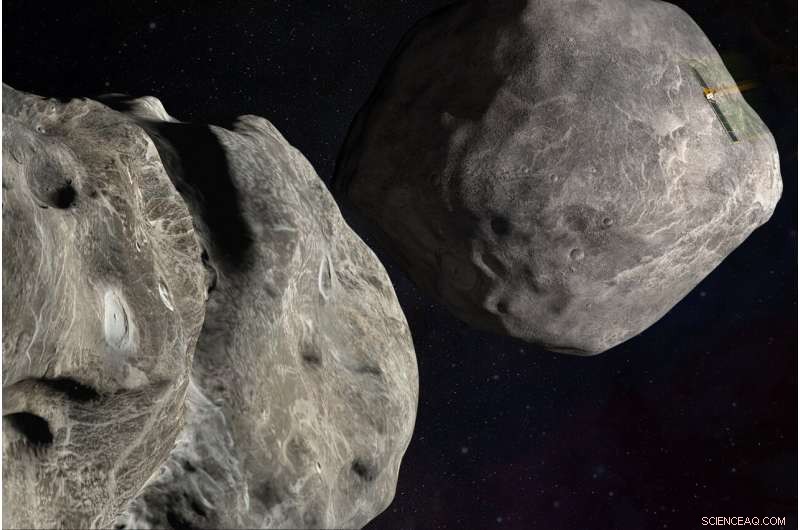
This illustration made available by Johns Hopkins APL and NASA depicts NASA's DART probe, upper right, on course to impact the asteroid Dimorphos, left, which orbits Didymos. DART is expected to zero in on the asteroid Monday, Sept. 26, 2022, intent on slamming it head-on at 14,000 mph. The impact should be just enough to nudge the asteroid into a slightly tighter orbit around its companion space rock. Credit:Steve Gribben/Johns Hopkins APL/NASA via AP
"The dinosaurs didn't have a space program to help them know what was coming, but we do," NASA's senior climate adviser Katherine Calvin said, referring to the mass extinction 66 million years ago believed to have been caused by a major asteroid impact, volcanic eruptions or both.
The non-profit B612 Foundation, dedicated to protecting Earth from asteroid strikes, has been pushing for impact tests like DART since its founding by astronauts and physicists 20 years ago. Monday's feat aside, the world must do a better job of identifying the countless space rocks lurking out there, warned the foundation's executive director, Ed Lu, a former astronaut.
Significantly less than half of the estimated 25,000 near-Earth objects in the deadly 460-foot (140-meter) range have been discovered, according to NASA. And fewer than 1% of the millions of smaller asteroids, capable of widespread injuries, are known.
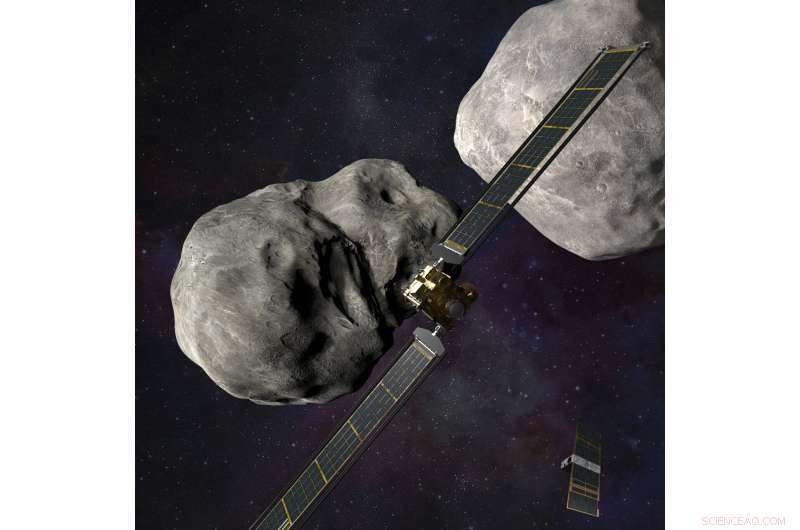
This illustration made available by Johns Hopkins APL and NASA depicts NASA's DART probe, center, and Italian Space Agency's (ASI) LICIACube, bottom right, at the Didymos system before impact with the asteroid Dimorphos, left. DART is expected to zero in on the asteroid Monday, Sept. 26, 2022, intent on slamming it head-on at 14,000 mph. The impact should be just enough to nudge the asteroid into a slightly tighter orbit around its companion space rock. Credit:Steve Gribben/Johns Hopkins APL/NASA via AP
The Vera Rubin Observatory, nearing completion in Chile by the National Science Foundation and U.S. Energy Department, promises to revolutionize the field of asteroid discovery, Lu noted.
Finding and tracking asteroids, "That's still the name of the game here. That's the thing that has to happen in order to protect the Earth," he said. + Esplora ulteriormente
© 2022 Associated Press. Tutti i diritti riservati. Questo materiale non può essere pubblicato, trasmesso, riscritto o ridistribuito senza autorizzazione.